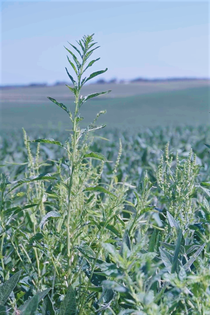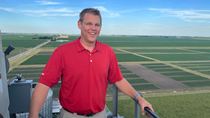Most in the industry.
11 Herbicide Modes of Action.

Agriculture
Imagine you’re a mechanic- toolbox full of essentials: various size wrenches, screw drivers, drills. But one by one your tools get rusty, wear out and break until you’re left with very few. You’re now infinitely less efficient at your job of getting people back on the road. That’s what it’s like for farmers today facing weeds that are becoming resistant to herbicide treatment. What they need are multiple modes of action, or tools in their toolbox. It's how they stop growing weeds and start growing the crops that make our food, fuel and fiber.
From tractors and drones to chemicals, farmers are known to get quite a few drop-ins from industry representatives making inquiries. But today, it’s Kent Johnson, a third-generation farmer from Clemons, Iowa, who has a question for his visitor.
What new chemistries are you going to bring to help us?
As he surveys his land – acres of corn and soybeans nestled right in the heart of Iowa – he sees weeds like waterhemp and Palmer Amaranth become more prolific, while others like foxtail manage to evade pesticide applications. He pays close attention to these trends because he knows without proper management, weeds can quickly spiral out of control, out-competing crops for valuable space, nutrients, and water. These dynamics, set against growing public concern for the chemical tools that are critical to keeping his operation running sustainably, have him worried.
“I know it's a costly endeavor for companies to create new herbicide chemistries,” Johnson says. “And the last thing I want to see is for us to lose any of the existing tools in our weed management toolbox. Because if we do, since there's nothing really replacing them, we're going to be in a sad shape. It's no different than when I'm working on a piece of equipment. If you take one of my tools away, I'm going to have one hand tied behind my back. As far as weed control, lack of tools is going to lead to harvestability issues and reduced yield.”
Johnson’s family farm is one of more than two million farms in the United States. These growers have the biggest job on Earth – according to estimates compiled by the United Nations, 60 percent more food will be needed by 2050 when the population is expected to top 9.8 billion. The stakes are high, and made harder by factors such as environmental challenges, climate change and shifting weed pressures that test farmers’ skills and resilience daily.
Despite the best efforts and forward-thinking practices of growers like the Johnson family, weeds continue to evolve, and herbicide innovation has struggled to keep up.
Dr. Bryan Young, a weed science professor at Purdue University, explains that herbicides weren’t used until the 1900s and quickly became valuable tools. “In the 1800s and early 1900s, weed control was cultural and mechanical. When herbicide technology became available, growers switched to these methods as they required fewer people and were more effective. They could cover more acres and do so more easily than with other methods. And, as we were coming out of the Dust Bowl and reducing tillage practices, herbicides provided a manner to control weeds that didn’t disturb the soil.”
Herbicides quickly became the main tool for many growers to manage weeds. However, with a limited number of herbicides on the market, it wasn’t long before weed resistance entered the scene. Like bacteria that become resistant to antibiotics, weeds can become unaffected by herbicides and new chemistries are needed to control them. Today weeds have evolved resistance to 21 of the 31 known herbicide sites of action and to 165 different herbicides. The last differentiating new herbicide mode of action was introduced in 1989, more than 30 years ago.
This dynamic leaves a huge void for growers, and it has Johnson worried. He explains, “We have many weed species, and because of that, we need many products to stay diversified and avoid creating additional resistance problems.”
“The biggest challenge is that we don’t have resistance to a single herbicide; we have resistance to multiple modes of action,” Young adds. “What herbicides are left? We’re on a herbicide treadmill and hoping for the next herbicide active ingredient to come along.”
And so, the quest for new herbicides continues. While many companies have decreased their investment in herbicide research, BASF has dived head first into the challenge to meet growers’ needs.
“The strategy is to keep existing modes of action effective, and also keep developing new modes of action. That way, farmers have the most enduring options to control weeds and effectively manage resistance” says Padma Commuri, head of R&D in North America for BASF Agricultural Solutions. “We have a long-standing expertise and understanding of herbicide chemistries and their modes of action, and we apply that to overcome resistance with modifications to known chemistries and to discover new ones.” This expertise is behind their leading position in the market, where BASF offers 11 different modes of action- the most in the industry.
Most in the industry.
11 Herbicide Modes of Action.
One of those existing tools that is important to keep in the toolbox are the PPO herbicides, or protoporphyrinogen oxidase inhibiting chemistries. They play a major role in weed management programs by clearing fields of yield-robbing weeds before crop seeds are nestled into the soil. But some weeds are growing resistant to PPO herbicides, stubbornly remaining in the field to siphon away resources from crops even after they’re treated.
Weeds, like those in the Amaranth family, have developed resistance to herbicides. Left unchecked, they tower over crop plants, out-competing them for resources like sunlight.
BASF aimed its discovery engine at PPOs to preserve this essential mode of action. Incorporating several tweaks to traditional PPO-herbicides, they developed Tirexor® herbicide, which provides strong control of herbicide-resistant weeds, even PPO-resistant ones. To follow that, they are advancing another new PPO chemistry that will help keep this essential mode of action in the toolbox.
“All the chemistries we develop must pass a high bar with respect to their safety, their impact on the environment and their effectiveness” says Peter Weinert, Vice President of Herbicides Marketing for BASF, whose team is responsible for managing BASF’s current herbicide active ingredients and new innovations. “Our modes of action that are registered already today meet those criteria, which is why they are essential for farmers managing weed resistance. This high bar of criteria, at the same time, creates a big challenge, and is why new modes of action are not frequently brought to market.”
Although the discovery and regulatory process is complex, Commuri sees cause for optimism. She is particularly excited about a recent addition to the herbicide pipeline that will improve weed management options for farmers into the future. “We’ve got an entirely new mode of action to bring to farmers. And not only that, but we are also developing it with a herbicide tolerant trait,” adds Commuri. The new herbicide trait will be developed and available in a herbicide tolerant stack in collaboration with Corteva Agriscience.
“It is our goal to put multiple herbicide innovations in the hands of growers, so that they can meet their production goals while conserving their land for future generations to come,” said Weinert.
It takes the coordination of chemistries with traits and new technologies to control resistant weeds and that’s why our long-term strategy approaches farmer challenges from multiple angles.
Farmer, Kent Johnson, drives to one of his soybean fields
Johnson isn’t only a farmer; he’s also a consumer.
“I eat the food that we grow as much as anybody else. I do everything possible to keep a very safe level of products on our crops and away from our water table. Sustainability to me means leaving things better than I found them, and that’s what I work towards every day.”
As part of creating a better future, sustainability practices are always on display at the Johnson farm. They utilize cover crops to prevent erosion and to keep weed pressure down. This method also helps them use herbicides strategically; fewer passes with the sprayer means less opportunities to create chemical resistance, saving the valuable herbicide technology for where it’s most needed.
“Our soil is our number one resource and not depleting it in any way, shape or form is a top priority,” said Johnson. “From seed coatings to herbicides and insecticides, I'm trying to make sure that no matter what we do, we are building rather than depleting.”
Kent Johnson’s experience reflects the reality that most farmers are facing today. More than ever, they need to balance increasing complexity – managing resources, people, technology, climate and uncertainty - in order to produce enough food, fuel and fiber in an economically sound way.
With an eager eye towards new weed management innovations on the horizon, Johnson remains optimistic and committed to working and preserving his family’s farmland.
Published December 1, 2022
For media inquiries or to repurpose the story, please contact: katie.lelito@basf.com
.mp4%20(1080p).00_05_56_18.Still014.png)


